Welcome to the /r/coins “What’s Up With My Coin?” List! Frequently, we get posts asking us “is this damage? is it an error? what’s it worth?”. Well, if you can find your coin (or something similar) on this list, now you know what’s happened to it!
HOW TO USE THIS LIST: Scroll down until you see something on the LEFT side that shows an issue like your coin has. The identification for the issue, and some additional info, is on the RIGHT side. You can click or copy the link at the top of the identification or the description to be taken directly to that issue in the future.
HOW TO USE THIS LIST: Scroll down until you see something on the LEFT side that shows an issue like your coin has. The identification for the issue, and some additional info, is on the RIGHT side. You can click or copy the link at the top of the identification or the description to be taken directly to that issue in the future.
| What it might look like, and a brief (literal) description of the issue: | What likely happened to it? |
There’s something stamped onto my coin!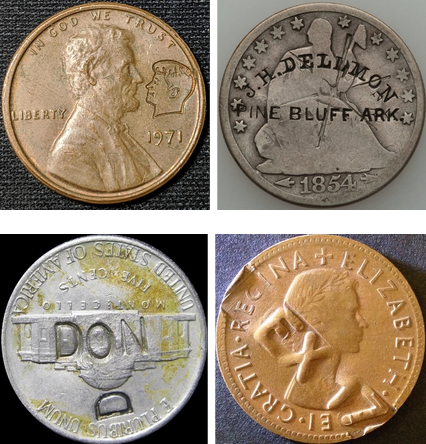 | Someone stamped something onto your coin. People have stamped stuff onto coins for centuries, for many reasons. Because it’s done to a coin post-mint, it’s considered damage, and not an error. Though there’s no “official” consensus on the terminology, there are different terms for stamped coins, depending on who did it and why, ordered below from most common to least common.
|
My coin has a ring (or curve) on it!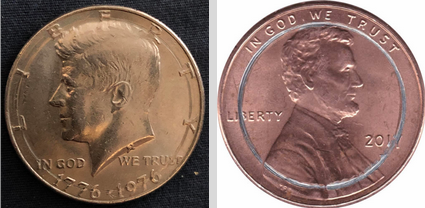 | It’s coin roller damage. Some coin rolling machines, when they tuck or crimp the wrapper around either end of a roll of coins, make a circular or curved scratch on the end coins of the roll. These can range from very light to fairly deep. While kind of cool-looking, this is considered damage and is not an error. Some call this type of damage the “ring of death.” Value: Damage, no value beyond face. |
My US coin has no mint mark!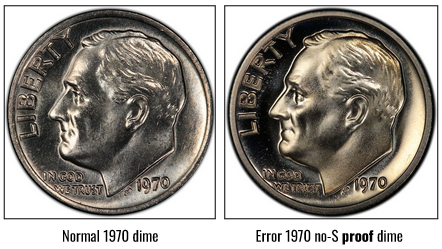 | It was minted in Philadelphia (probably). US coins made in Philadelphia (other than nickels made in 1942-1945) did not have mint marks until 1979. US pennies made in Philly have never had mint marks, except in 2017! So it’s likely your “no mint mark coin” is a US coin that was minted in Philly. The Philly mint was the first, so originally there was no reason to designate the mint – because every coin was a Philly coin. This continued after other mints opened, even though coins made elsewhere were given marks (e.g. D for Denver, S for San Francisco). More about US mint marks. However, there have been rare errors in which a coin should have a mint mark, but does not. These include the circulation-issue 1922 no-D cent and 1982 no-P dime errors. Even rarer, in proof issues, there is the 1990 no-S proof cent, the 1971 no-S proof nickel, and the no-S proof dimes in 1968, 1970, 1975, and 1983. Proofs are specially-made, collector versions of coins (more info on proofs). And here are some tips for telling whether you have a proof, or a normal (non-proof) coin. Bottom line: If you found it in circulation, other than a 1922 cent or 1982 dime, your “no mint mark” coin is probably a Philly-minted, normal “circulation strike” coin – and probably not a proof. Value: Face value unless it is one of the rare varieties outlined above. |
The rim of my coin is raised up OR the edge of my coin is flat OR my coin is too thick!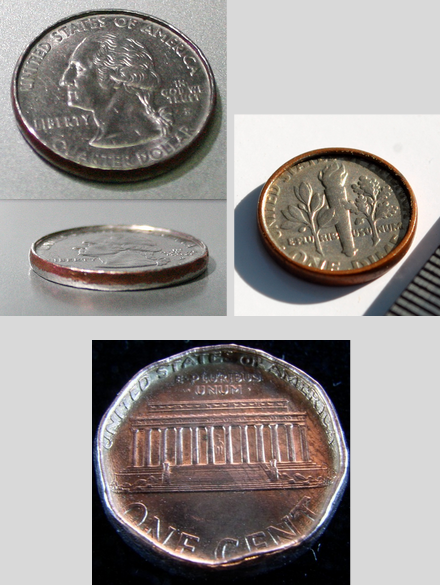 | You have a dryer coin, or maybe a spooned coin. What’s a dryer coin? A coin in a pocket may fall out when clothes are laundered, and get trapped in a clothes dryer… and then, a few things can happen. For example, the coin may be rolled between the stationary outer drum and the rotating inner drum (see the drawing below). Heat, plus constant pressure to the coin’s edge, may flatten it, and also raise and even curl the rim inward. The quarter and dime on the left are rolled dryer coins — note that the originally reeded edges of the coins are flat as a result. This is damage, not an error. 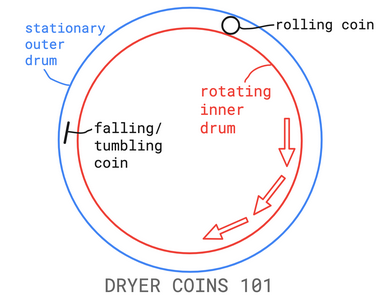 Clothes dryers are good at deforming coins in different ways. (Another is mentioned in the entry below.) Another possibility is that you have a spooned coin. One way to turn a coin into a ring starts with repeatedly tapping the edge of the coin, for example with a spoon, to broaden and raise the rim. Spooned coins are usually rougher-looking and less perfectly-circular than dryer coins. The penny on the left is an example of a spooned coin. This is also damage, not an error. Value: Damage, no value beyond face. |
My coin is smoothed / rounded over!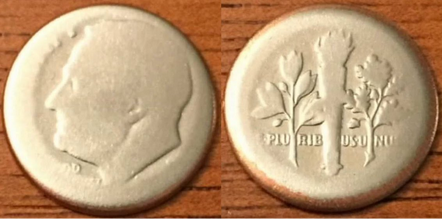 | You have a dryer coin as well. The entry above is about one kind of damage that a clothes dryer can do to a coin, when it gets rolled between the inner and outer drums. Another kind of damage is from being tossed and tumbled between the hard surfaces of the drums. This repeated battering of the coin tends to smooth or “round over” the surface details, making it look extremely, but usually evenly, worn. Often these two effects happen on the same coin, if the unfortunate thing is trapped in this hostile environment for long enough, with the result of a coin having both a raised/curled edge and details that have been pummeled into mush. Follow the links below for a bunch of extreme examples (WARNING: graphic coin gore ahead!): Value: Damage, no value beyond face. |
The edge of my coin is missing / grooved / channeled OR my coin looks like an Oreo!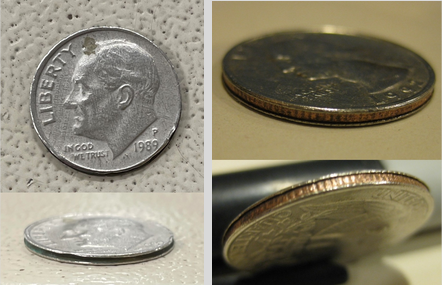 | You have an Oreo coin!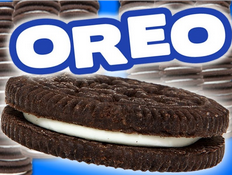 No, that’s not an official term (although it should be!). But this effect is seen in clad coins, such as post-1964 US dimes and quarters, which are made of two cupronickel/CuNi alloy layers that sandwich a core of pure copper. On clad coins, the copper core is normally visible on, and flush with, the edge of the coin. Copper is more chemically reactive than cupronickel – meaning that it’s less resistant to corrosion when exposed to corrosive substances like salt water and acidic liquids. So, when exposed to these substances, the copper gets eaten away quicker than the cupronickel, causing the core layer to become recessed from the outer edge… like an Oreo cookie. Coins with this effect are considered damaged, and are not errors. Value: Damage, no value beyond face. |
My penny is silver-colored!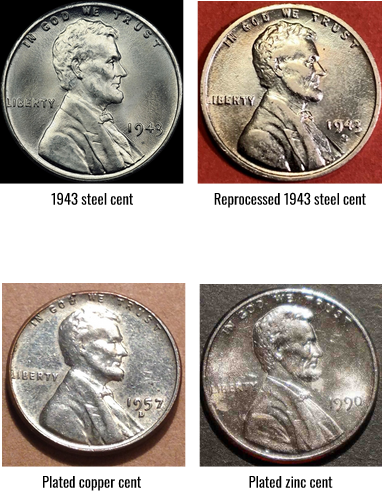 | It’s either a steel penny, or a painted/plated copper penny. Check the date first against this list:
Value: See above list for general guidance on values. |
My coin is strangely colored!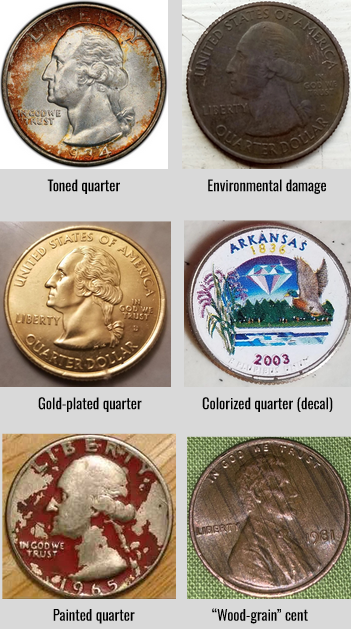 | It’s toned, OR has environmental damage, OR was plated/painted/altered. These effects can happen to most any coin, but US quarters are used in this example.
|
My coin is hollow!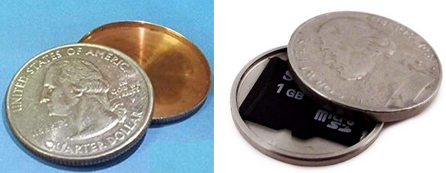 | It’s a magician’s coin — or a “spy coin.” Hollow coins have a few uses, such as in coin magic, or to conceal something small, and sometimes are made from an actual coin by separating the coin into two halves, and milling out the interior. As magic props, they’re sometimes called “shells” or “turtles.” Nowadays, hollow coins may be manufactured, allowing for all kinds of configurations. For example, an “expanded shell” is a fake, hollow coin that is made large enough to fit over a real coin of the same denomination. A “super expanded shell” is one large enough to fit over an expanded shell, and so forth. Because these items are altered coins or are wholly fake, they are not errors, only damaged, if they are even real coins. Value: Damage, no value beyond face if real. |
My coin has two heads (or two tails)!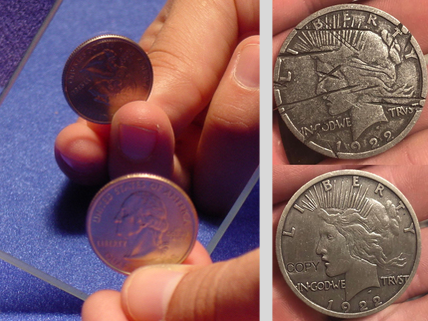 | It’s a 99% chance of being a fake, sorry! What’s neat about them, though – the good ones made from real coins, at least – is the way they’re made can fool you into thinking they’re real. Most are not produced by sticking together two half-coins – this would leave a tell-tale seam around the edge. Rather, one side of a first coin is hollowed out to leave the rim intact, and then a second coin is shaved down to fit inside the first – this hides the seam on one face of the “double-sided coin,” close to the rim. Of course, like magician’s coins, a double-sided coin may be completely fake, like replicas of Two-Face’s famous two-headed 1922 Peace dollar coin (an example is shown on the left). There are only a few instances of the US Mint actually producing a double-sided coin. One example is a two-tailed quarter (more info here), and another is a two-headed nickel (more info here). However, the circumstances in both cases indicate that they were made intentionally by Mint employees. This doesn’t happen by accident because the dies used for obverse and reverse sides of a coin are made to eliminate the possibility of such an error — for example, by using differently-shaped shafts that can’t be accidentally interchanged. Because these items are either altered coins or are wholly fake, they are not errors, only damaged coins if real. Value: Damage, no value beyond face if real. |
My coin has a hole through it!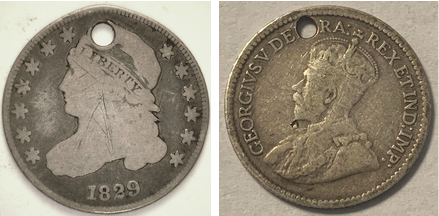 | Someone put a hole through your coin. This is most often seen on older coins. The theory is that holes near the rim are so the coin could be worn as a charm or bracelet, or kept on a string, practices more common in bygone days (more examples). Holes punched near the center may have been to use the coin as a button, or a washer. This is damage, and not an error. Like other forms of damage, a hole punched through a coin decreases its collector value. Another possibility, with modern bi-metallic coins made of a ring of one metal around a core of another metal, is that one has come apart or was broken apart. This can leave a holed partial coin (example). If that’s what you have, it’s also considered damage, not an error. But also keep in mind that many non-US coins have a hole as a part of the design, such as these. Use the info on the coin to look it up, e.g. on Numista. Value: Likely no additional value beyond face if damaged. |
My coin is double stamped!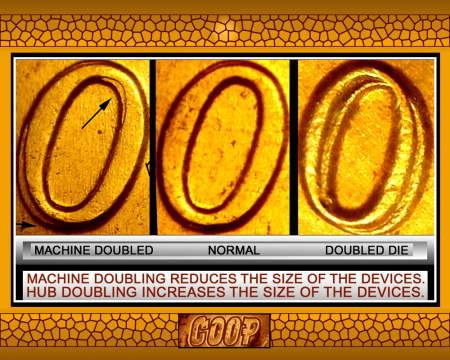 | It’s either machine doubling (likely) or a doubled die (unlikely). There are two types of doubling on coins, machine doubling (MD) and doubled dies (DD). Both are described below.
Value: See above for general value guidance. |
My coin is missing stuff in the design / letters / numbers!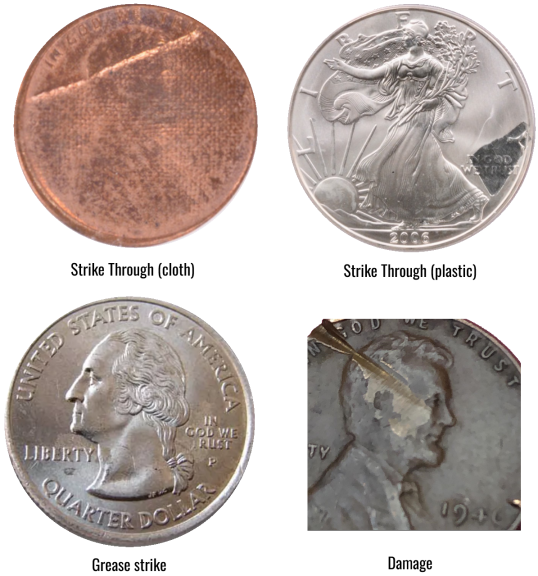 | It’s either a strike through error OR a grease strike OR just damage. There’s three main ways a coin can be missing part of its design.
|
My coin has extra bits of metal on it / in the design!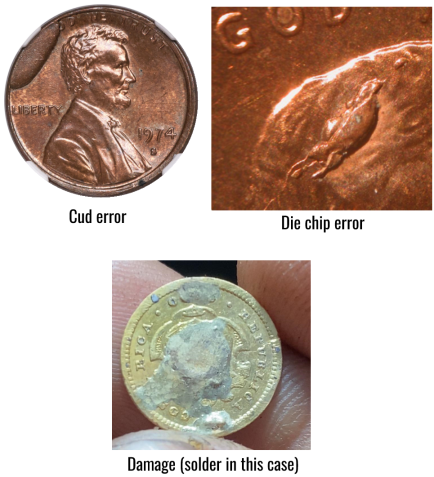 | It’s either a cud, die chip, or damage. Depending on where on the coin the extra metal appears, it could be any of the above 3 issues. If the extra metal is:
|
My coin has bubbles / bumps / craters below or on the surface!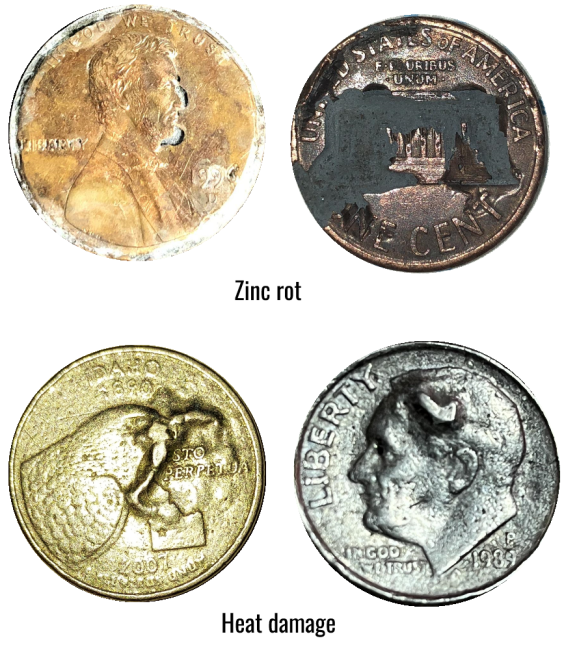 | It’s either zinc rot (in the case of pennies) or heat damage (in the case of other coins). Both of these are damage, not an error. Zinc rot occurs to pennies when carbon dioxide is exposed to the inner zinc layer of the penny, tarnishing it and making it extremely brittle and prone to breaking off entirely. Heat damage occurs when the coin’s inner layer melts or separates from the outer layer, causing visible “bubbling” on/below the surface of the coin. See the photos to the left for examples. Value: Damage, no value beyond face. |
My coin has a mirror-like finish!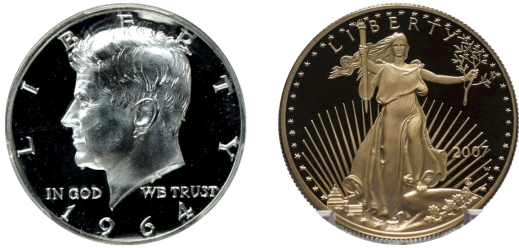 | It’s a proof coin! Proof coins are those that are made generally for collectors, and are rare to find in circulation. If you found a proof in circulation, lucky you! While it won’t make you rich, it’s still neat to find them when most, if not all proofs are Not Intended For Circulation (NIFC). Value: Highly dependent on which proof you have found. |
My coin has chunks out of it, and/or strange bits of different color, and/or is bent, and/or has gouges, and/or has scratches!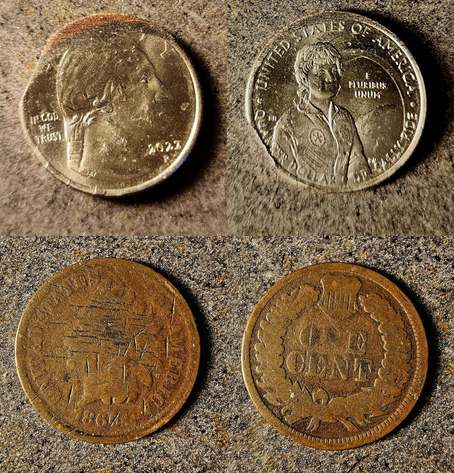 | It’s just damage. We get asked about damaged coins very frequently, and there are an infinite number of ways a coin can be damaged post-mint. It would be nigh impossible to list all the ways a coin can be damaged here, but this covers a good portion of ways a coin can be damaged. If your coin is still in circulation, you might as well spend it and not keep it, it’s still worth face value. If your coin is older and not in circulation, you can either spend it (it’s still legal tender, after all!), or keep it if you still want to. Damage does not add any additional value, but can remove value potentially if severe enough and done to a more collectable coin. Value: Generally face. See above for exceptions. |
My Lincoln Cent has the “L” on the edge / rim!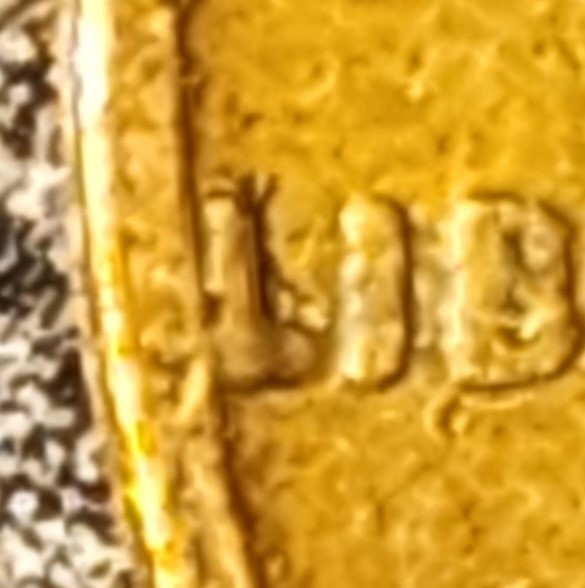 | It’s just normal wear / within spec. This is not an error. A large percentage of wheat cents, and even newer memorial and shield cents have the “L” in Liberty touching the rim. Significant wear can make this look even more dramatic. This doesn’t add any value and does not make the cent more collectible. Value: Face. |
My nickel may have “full steps”!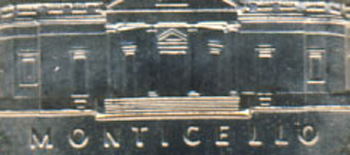 | All about “full steps” nickels and how to PROPERLY make the determination. We have been asked this question a lot, and we thought it was high time to answer it. For some context, a “full steps” nickel is a nickel which, on the Monticello reverse (so, 1938-present), has 5 (or 6) fully outlined steps on the staircase leading to the building. When trying to make the determination on if a nickel has “full steps” or not, ask yourself the following:
Value: Face for non-full steps, value varies greatly for full steps depending on other factors (date, mintage, etc.). |
My American Women Quarter says “In Cod We Trust”!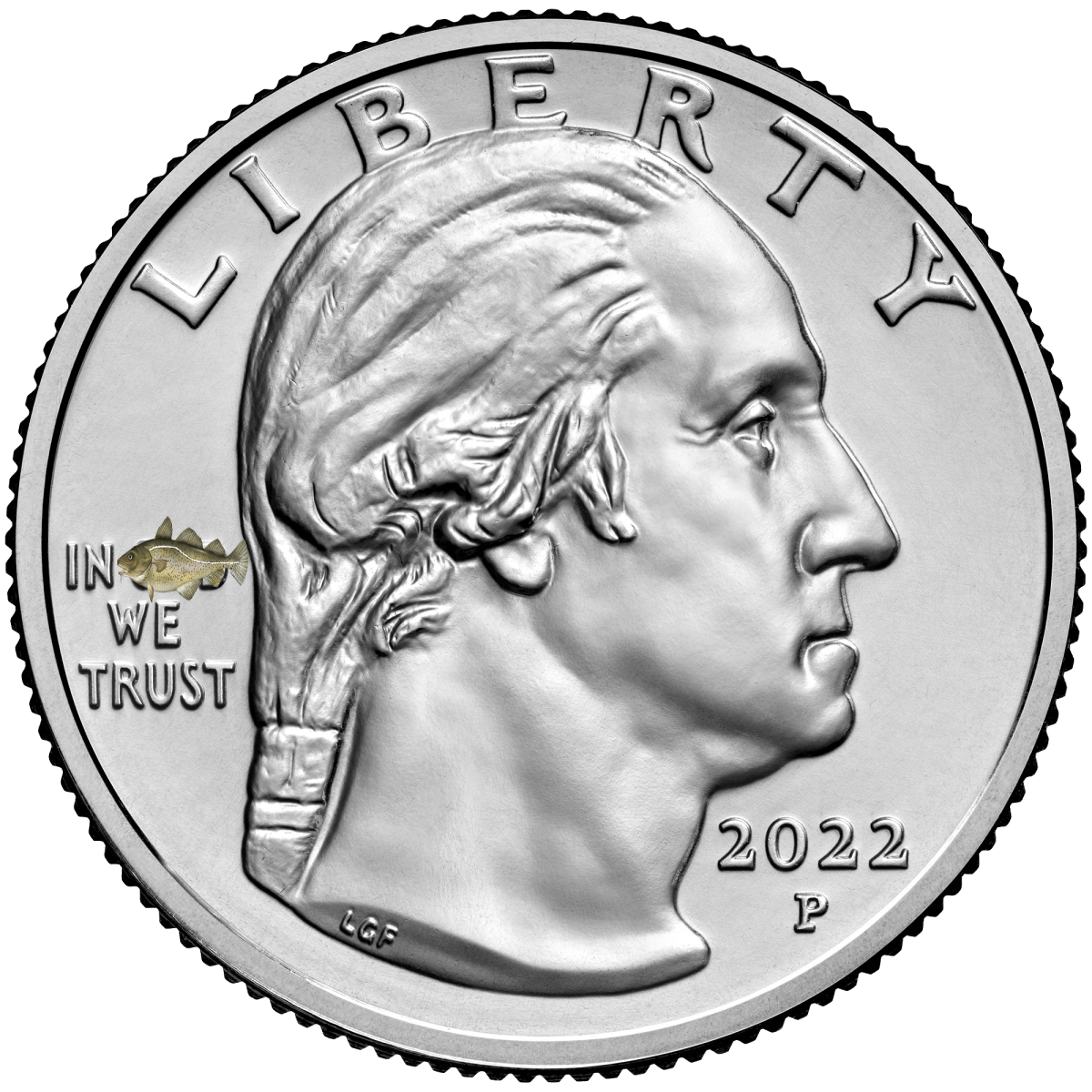 | Actually, it doesn’t. Simply put, the font was a poor choice from the coin’s designers, and leads to it LOOKING like it says this ridiculous phrase, but if you look under a microscope or sufficient jeweler’s loupe, it will be a “G”, not a “C”, 99.9999% of the time. Value: Face. |
| ??? Or, “hey, my coin’s issue is not on this list!” | We get asked this question A LOT, so we try our best to keep this list updated with the most frequent examples. If you don’t see anything like your coin on here and were redirected here by a mod, then please send us a modmail (link below) and we will update the page with your example and what’s going on. |
This list is maintained by the moderation team at /r/coins. If you wish to see a type of issue added to this list, please send a message to the moderators and we will consider your request.
Total pageviews: 15,708